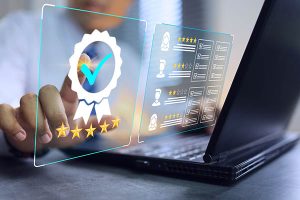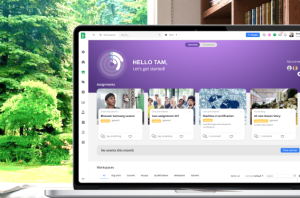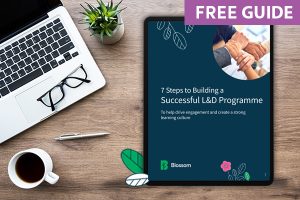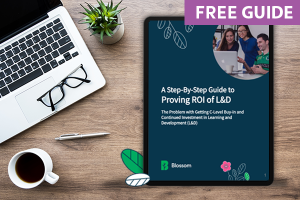Revamp your approach to showcase impactful L&D outcomes with people data. Master storytelling with People and Learning Analytics to get C-Suite buy-in.
Learning and development (L&D) teams face many challenges in securing buy-in from the C-Suite for several reasons. One obstacle is a lack of robust data and metrics demonstrating learning programs’ return on investment (ROI).
If L&D efforts are not linked to key performance indicators or the impact on the bottom line is unclear, C-Suite executives may perceive them as separate from strategic business objectives, leading to skepticism and underfunding.
Translating L&D initiatives into tangible business outcomes that align with broader organisational goals doesn’t have to be challenging.
Discover how to leverage storytelling to simplify complex L&D data. Explore five examples that can help you showcase the ROI, a metric valued by C-Suite leaders, to secure their support.
The power of storytelling for L&D
L&D teams can leverage data, including learner completion rates and engagement metrics, to inform, evaluate, and improve training programs. Metrics not only indicate the number of employees accessing learning programs but also align with broader business objectives, showcasing the collective effort of employees, managers, and other stakeholders.
Data storytelling involves using this data to convey a narrative or story. It requires presenting data in a way that is meaningful, engaging, and easily understandable to an audience.
So, instead of simply presenting raw numbers or statistics, data storytelling can showcase an impact that resonates with your C-Suite. Compelling data storytelling typically includes:
- Human connection. Anecdotes, real-life scenarios, or examples make the data more relatable and connect with the C-Suite on a personal level. This can include using an employee’s actual words that authentically capture the personal impact of the data, bringing a genuine and relatable perspective to the information presented.
- Contextualisation. Placing data within a broader context to help the audience understand its relevance and significance, for example, linking a success story about how a new training program has developed leadership skills for middle management.
- Visualisation. Extensive blocks of text can be less user-friendly. Charts, graphs, and other visual elements make complex data more accessible and compelling.
- Key insights. Highlight key takeaways or insights from data to reinforce the main message linked to organisational priorities. For instance, new hires achieving the required level of competence 25% faster or a decrease in the number of customer complaints.
By combining these elements, data storytelling transforms raw data into a powerful communication tool, making it easier for C-Suite to understand, remember, and act on the information presented.
Use existing data to facilitate C-Suite buy-in
People and learning analytics can strategically secure C-Suite buy-in and gauge the impact of training programs. Presenting stories alongside data, instead of solely sharing statistics, fosters transparency. This approach empowers C-level executives to make informed decisions grounded in facts rather than assumptions.
Let’s examine how people analytics can be used to showcase the impact of L&D initiatives through storytelling.
We’ll share five examples of how you can use L&D data to highlight transformative outcomes and get C-Suite buy-in.
1. Demonstrate the impact of employee skill development
Employee skill development data and analytics offer valuable insights into the effectiveness of training programs and the progress of individual employees. These analytics provide measurable outcomes of training initiatives, such as time to competency and compliance requirements.
Plus, this data allows you to personalise training programs by analyzing employees’ progress through learning paths and responses to different modules. These data insights can reveal a significant increase in employees’ proficiency in a specific skill.
Highlight how tailored content has enhanced engagement and accelerated skill development with our example next.
Story: Marketing Campaign Success at 123 Marketing Agency
Hanza, a social media marketing professional, completed specialised training in data analytics and digital marketing. Armed with his new skills, he was crucial in analyzing customer behaviour data for a major client campaign at 123 Marketing Agency. By applying insights gained from the training, Hanza contributed to a targeted data-driven marketing strategy. The campaign resulted in a 30% increase in customer engagement and a notable boost in the client’s sales figures.
Highlight individual success stories of employees who applied newly acquired skills to contribute to projects, improving team performance and project outcomes.
Blossom can provide comprehensive data and reporting tools to help you showcase the impact of your L&D programmes. Customisable reports, dashboards, and insights offer a detailed overview, allowing you to communicate the success of training and development initiatives effectively.
2. Evidence L&D ROI
Skill development data allows L&D teams to quantify the return on investment (ROI). Tangible metrics, such as improved job performance or increased productivity, provide concrete evidence of the collective impact of L&D initiatives.
Demonstrate ROI to C-Suite by regularly analyzing skill development data. Show how you and your teams have made data-driven decisions by identifying what works well and needs adjustment. Use stories to showcase how training programs have evolved to meet changing organisational and employee needs and get C-Suite support.
Highlight how investment in a leadership development program resulted in measurable improvements in employee retention, leadership effectiveness, and subsequent financial gains for your organisation.
Story: ABC Financial Services Executive Coaching
A financial services firm provided executive coaching as part of its leadership development program for senior executives. A survey conducted after the training indicated a notable increase in leadership effectiveness, with executives reporting improved decision-making and strategic vision.
What’s more, the organisation’s commitment to leadership development attracted top talent, resulting in a 15% increase in new client acquisitions and a significant boost in overall profitability.
3. Illustrate e-learning success
Learning engagement metrics provide insights into how employees interact with training materials and participate in learning activities.
For example, analyzing metrics on a particular e-learning course can identify which modules, courses, or learning resources are most popular among employees. This information helps refine and expand content that resonates well with the workforce.
Present a narrative to the C-Suite on how interactive and engaging learning modules increased participation, knowledge retention, and positive feedback, ultimately enhancing the overall learning experience. Get continued support for ongoing L&D investment.
Story example: Random Tech E-Learning Success
A technology company implemented interactive learning modules for its software development team. The modules included gamified coding challenges, interactive simulations, and virtual collaboration exercises.
As a result, participation rates soared, with team members eagerly completing modules during work hours. The interactive elements make learning enjoyable and contribute to a 20% increase in knowledge retention. Positive feedback flooded in, praising the company for its innovative approach to employee development, ultimately enhancing the overall learning experience.
4. Reveal alignment with business goals
Align L&D metrics with broader organisational goals. For instance, if one of your organisational priorities is to boost customer satisfaction, highlight L&D metrics that show how training programs improve employees’ customer service skills.
Story example: Exceptional Guest Experience at a Luxury Hotel
Jane is a front desk hospitality manager at a renowned luxury hotel. The hotel management identified the need to enhance guest experiences by integrating innovative technologies and personalised services.
Jane enrolled in a comprehensive L&D program covering hospitality technology trends, guest relationship management, and cultural sensitivity training.
Equipped with her newly acquired skills, Jane spearheaded the implementation of a digital concierge service that allowed guests to customise their stay through a mobile app. The innovative system provided personalised recommendations, seamless check-in/out processes, and instant communication with hotel staff. This not only elevated the guest experience but also positioned the hotel as a pioneer in leveraging technology to meet customer needs.
The successful adoption of this innovation resulted in increased customer satisfaction scores, positive online reviews, and a boost in the hotel’s market competitiveness, aligning perfectly with the company’s goal of being a trendsetter in the luxury hospitality sector.
5. Highlight diverse employee learning needs
Adaptation to remote learning involves identifying the strategies and approaches that worked well during the transition. Analytics, such as data on user engagement, completion rates, and feedback, play a crucial role in this process. By leveraging these analytics, you can gain valuable insights into the effectiveness of specific tools, platforms, and instructional methods.
For example, analytics can reveal patterns in online interactions, guiding you on the best timing for sessions or activities. Understanding participant feedback and performance metrics helps refine instructional strategies, ensuring remote learning meets diverse learner needs.
Story example: Sea Cargo Handling Services excels at safety standards
A transportation and logistics organisation faced challenges as travel restrictions impacted their ability to conduct hands-on training for ground handling staff. Ensuring safety protocols and maintaining operational efficiency were critical concerns.
The L&D team embraced a remote learning approach by developing online modules focused on safety procedures, cargo handling protocols, and emergency response. Data analytics were used to track completion rates, assess quiz results, and identify areas of strength and improvement among the land-handling staff.
Data showed that employees did well in safety and emergency response training. The L&D team noticed this and arranged virtual drills to improve practical skills. This helped the land-handling staff smoothly shift to remote work, keeping upskill efforts and safety standards intact, even during challenges.
Get C-Suite buy-in by illustrating the seamless transition to remote work without compromising productivity.
Leverage an emotional connection to get C-Suite support
Storytelling invites the C-Suite to grasp and emotionally connect with the significance of your L&D initiatives.
Sharing stories of experiences, challenges, and successes can establish a genuine emotional connection. This connection bridges the gap between the details of L&D programs and the broader vision of the C-Suite.
When you narrate stories of individual growth, team success, and the overall impact on the organisation, you construct a narrative that feels personal and relatable, ultimately resulting in C-Suite buy-in.
Blossom can help your organisation use L&D data to facilitate C-Suite buy-in. Schedule a demo today with one of our friendly experts.








